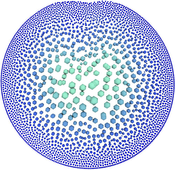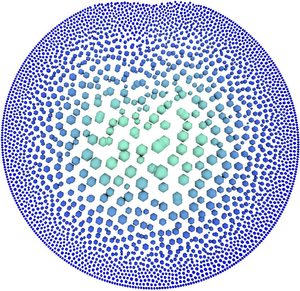Information
- Publication Type: Master Thesis
- Workgroup(s)/Project(s):
- Date: May 2022
- Date (Start): December 2018
- Date (End): May 2022
- TU Wien Library:
- Second Supervisor: Johannes Unterguggenberger
- Diploma Examination: May 2022
- Open Access: yes
- First Supervisor: Michael Wimmer
- Pages: 81
- Keywords: Position-Based Fluids, Particle-Based Fluid Simulation
Abstract
Position-Based Fluids (PBF) are a Lagrangian fluid-simulation method and are an implementation of Smoothed Particle Hydrodynamics integrated into the Position-Based Dynamics (PBD) framework. In PBD, constraints applied to object positions are used to enforce a variety of physical laws. In the case of PBF, the fluid is represented by particles and constraints are added that prevent fluid compression. The original PBF method defines all particles to be of equal mass and rest density. In this thesis, we propose a method for generalizing PBF to allow particles to represent varying amounts of fluid. This enables the fluid to be simulated with regionally varying levels of detail with the intent to reduce memory consumption and to increase performance. For each fluid region, we compute the targeted level of detail based on its distance to the fluid boundary, and use merging and splitting strategies to adapt the particles accordingly. We discuss the relation of the particle density to the kernel width used in PBF and provide several approaches for adapting the kernel width to fit the local level of detail. The advantages and disadvantages of each approach are evaluated and a streamlined implementation-variant is proposed which has advantageous properties for larger bodies of fluid. This streamlined solution bases the kernel width entirely on the boundary distance. Its approach is mathematically analyzed in regard to the expected number of particles and neighbor pairs for varying fluid body sizes. The mathematical analysis as well as measurements done in our test implementation show that while our method might increase the neighbor pair count for shallow fluids, it greatly reduces the number of particles and neighbor pairs if the fluid is sufficiently deep, giving the opportunity to significantly lower the computational effort in these cases.Additional Files and Images
Additional images and videos
 image:
A spherical shaped body of fluid where the proposed technique has merged some particles into particles with larger masses in the inner regions.
image:
A spherical shaped body of fluid where the proposed technique has merged some particles into particles with larger masses in the inner regions.
Additional files
Weblinks
BibTeX
@mastersthesis{geyer-2018-apbf,
title = "Adaptive Sampling in position based fluids",
author = "Lukas Geyer",
year = "2022",
abstract = "Position-Based Fluids (PBF) are a Lagrangian
fluid-simulation method and are an implementation of
Smoothed Particle Hydrodynamics integrated into the
Position-Based Dynamics (PBD) framework. In PBD, constraints
applied to object positions are used to enforce a variety of
physical laws. In the case of PBF, the fluid is represented
by particles and constraints are added that prevent fluid
compression. The original PBF method defines all particles
to be of equal mass and rest density. In this thesis, we
propose a method for generalizing PBF to allow particles to
represent varying amounts of fluid. This enables the fluid
to be simulated with regionally varying levels of detail
with the intent to reduce memory consumption and to increase
performance. For each fluid region, we compute the targeted
level of detail based on its distance to the fluid boundary,
and use merging and splitting strategies to adapt the
particles accordingly. We discuss the relation of the
particle density to the kernel width used in PBF and provide
several approaches for adapting the kernel width to fit the
local level of detail. The advantages and disadvantages of
each approach are evaluated and a streamlined
implementation-variant is proposed which has advantageous
properties for larger bodies of fluid. This streamlined
solution bases the kernel width entirely on the boundary
distance. Its approach is mathematically analyzed in regard
to the expected number of particles and neighbor pairs for
varying fluid body sizes. The mathematical analysis as well
as measurements done in our test implementation show that
while our method might increase the neighbor pair count for
shallow fluids, it greatly reduces the number of particles
and neighbor pairs if the fluid is sufficiently deep, giving
the opportunity to significantly lower the computational
effort in these cases.",
month = may,
pages = "81",
address = "Favoritenstrasse 9-11/E193-02, A-1040 Vienna, Austria",
school = "Research Unit of Computer Graphics, Institute of Visual
Computing and Human-Centered Technology, Faculty of
Informatics, TU Wien",
keywords = "Position-Based Fluids, Particle-Based Fluid Simulation",
URL = "https://www.cg.tuwien.ac.at/research/publications/2022/geyer-2018-apbf/",
}

 poster
poster thesis
thesis

